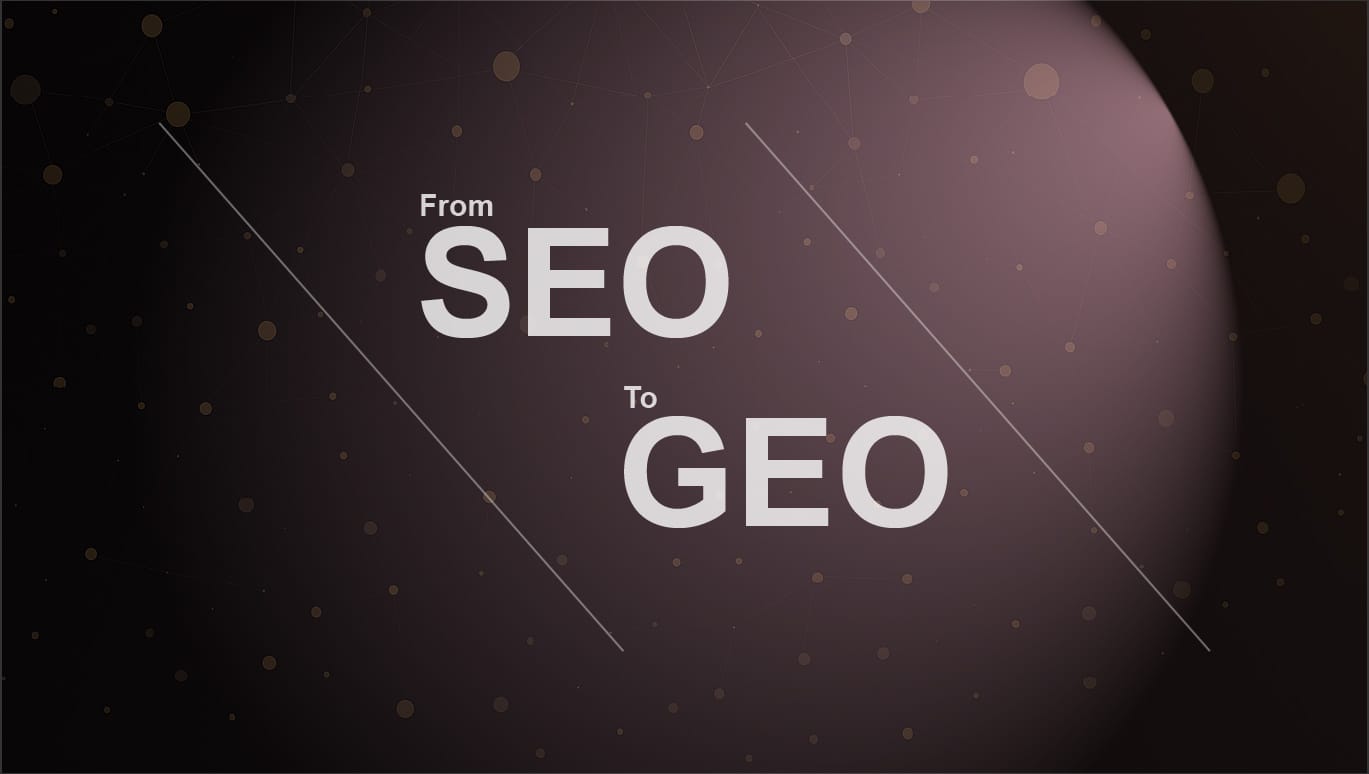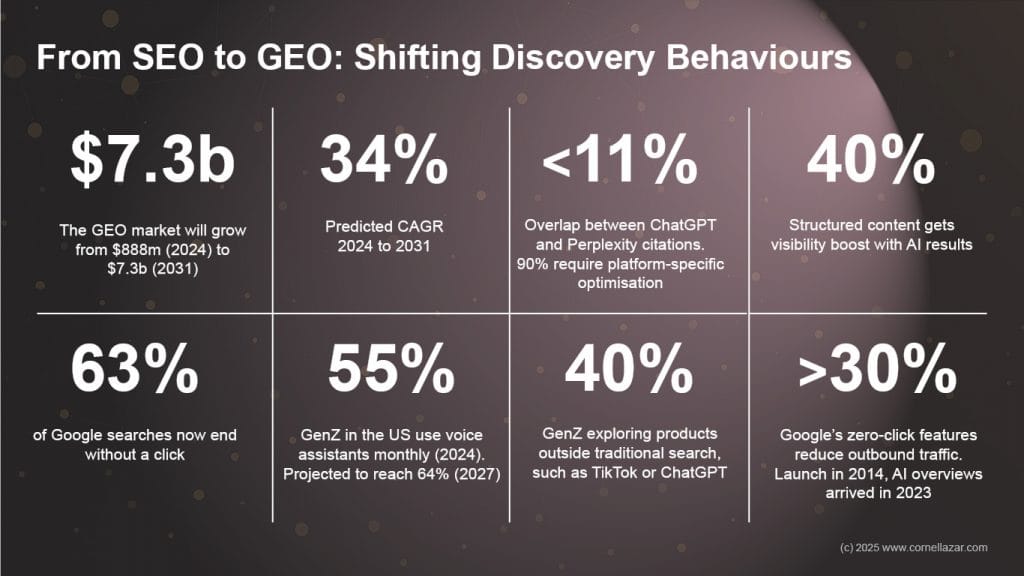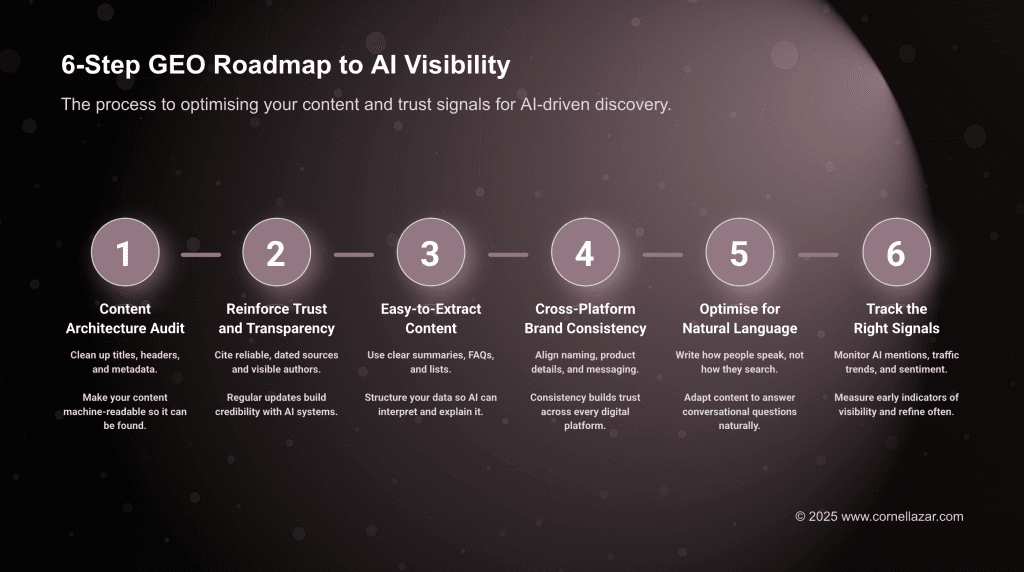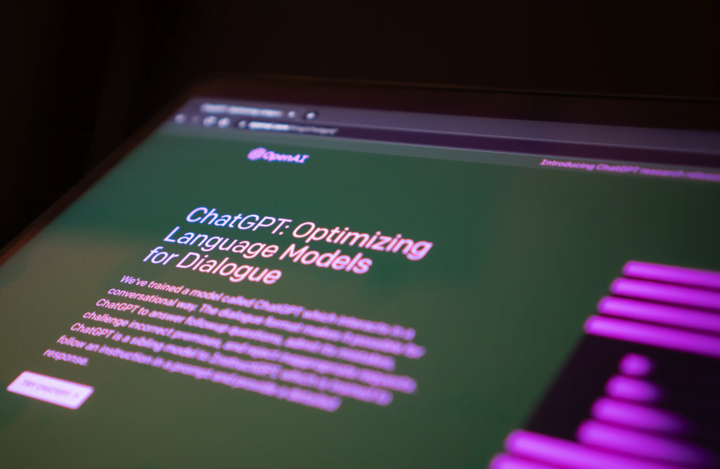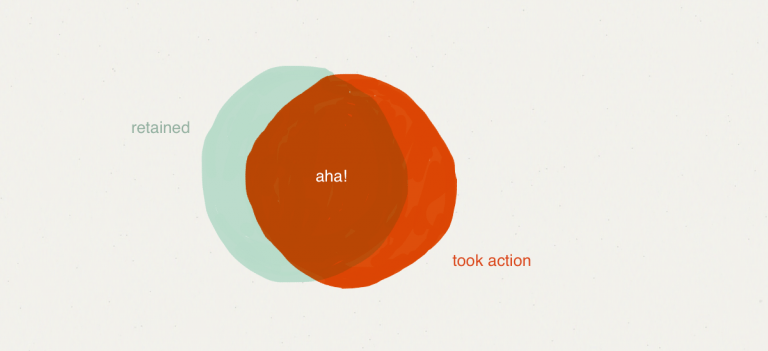Some Context First …
Let’s start with some perspective. The marketing world has never lacked buzzwords. But AI Visibility is not one of them. It marks a structural shift in how audiences find, evaluate, and trust brands.
I’m generally not one to publicly comment on every marketing trend, but conversations on GEO have been popping up everywhere with too many so-called AI gurus recycling assumptions as facts. The truth is, we’re currently all learning, experimenting, and making sense of this as we go.
A recent discussion in a WhatsApp group with trusted fellow senior marketers prompted me to share my take and my current understanding and help to separate signal from noise. Do I claim to be 100% correct? No, but let’s share what each of us has learned and is currently testing.
As marketers and consumers, we’re equally participants and witnesses to this wave of change. And this change feels fundamental.
GEO: Changing the Game and Why Pay Attention
Most marketing trends follow a predictable arc: Hype, adoption, fatigue. But AI-driven discovery is not another campaign layer; it’s a new operating system for how knowledge, intent, and trust are processed online.
We’re all still figuring it out, and this blog post is merely my current understanding I’m sharing and will evolve as we learn.
TL;DR
AI-driven discovery is changing how audiences find, trust, and choose brands. Traditional SEO still matters, but visibility now depends on how clearly AI systems can interpret and explain your brand.
Generative Engine Optimisation (GEO) is about structuring your content, citations, and trust signals so your brand appears within AI-generated answers and not just search results.
To prepare:
- Make your content machine-readable.
- Build credibility through transparency and factual accuracy.
- Structure information so AI can extract it easily.
- Keep your brand consistent across platforms.
- Write how people speak — not how they search.
- Track early signals of visibility and refine often.
In short: GEO isn’t another fleeting trend. It’s the next evolution of discoverability and the brands shaping AI knowledge now will own trust later.
The SEO Machine We Built
For over two decades, SEO was the backbone of digital visibility: keywords, backlinks, metadata, rankings. A system that rewarded precision and consistency. The formula was simple and powerful:
- Identify search intent.
- Produce content that ranks.
- Measure traffic and conversion.
Additional independent data from 2025 reinforces this shift.
The Pew Research Center reported in June 2025 that 34% of adults in the US had used OpenAI’s ChatGPT, roughly double the share from 2023.
In March 2025, the Imagining the Digital Future Center at Elon University found that 52% of US adults already use LLMs, such as ChatGPT to search for information.
Ahrefs’ April 2025 study confirmed that when Google includes an AI Overview, users click external sites about 35% less often.
These stats make it clear that discovery is moving away from traditional search and toward AI-generated answers.
The old model worked so well that most marketing teams were built around it. SEO turned visibility into a predictable science. But every system eventually hits its limits.
The Ground Starts Shifting
Even before AI came along, SEO was showing signs of fatigue.
- Google’s “zero-click” results were already eating into traffic.
- Voice search blurred the old keyword logic.
- SparkToro’s 2024 data showed that 63% of searches now end without a click, up from 50% in 2019.
- Statista’s June 2024 report found that Gen Z users are 40% more likely to start product discovery on TikTok or ChatGPT than on Google.
Those weren’t just early warnings — the data today confirms that this shift has become systemic.
Let’s Look At The Data Behind GEO
If you’re wondering whether GEO is just another short-lived acronym, the data says otherwise.
- The Generative Engine Optimisation (GEO) market is forecast to grow from $886m in 2024 to $7.3b by 2031, that’s an annual growth rate of 34% (CAGR). And while the market expands, AI-driven search traffic has already jumped 1,200% in nine months! (Sources: Marketing LTB 2024; All About AI 2024)
- Even Google’s AI Overviews are shifting click behaviour, reducing outbound traffic by roughly >30% on affected pages. Combine that with zero-click searches now accounting between 45% and 60% of certain query types.
- Platform data shines a light on additional complexities. One study analysing 100k prompts found only 11% overlap between ChatGPT and Perplexity citations. In other words: Nearly 90% of opportunities require platform-specific optimisation. (Source: Shane H. T., Medium 2024)
- Market share between LLMs is equally uneven: OpenAI’s ChatGPT leads with 60% of AI search traffic, with Microsoft Copilot at 14.4% and Google’s Gemini 13.5%. Each seems to prefer different content formats.
- ChatGPT favours encyclopaedic clarity, Perplexity weights user-generated discussion, and Copilot leans on business-grade sources like Forbes and LinkedIn. (Sources: All About AI 2024; Zen Agency 2024)
- More actionable for us is what has been proven to actually work. Princeton’s foundational GEO study identified that structured optimisation, such as citations, quotes, and statistics boosts inclusion rates by up to 40%. Particularly, comparative listicles emerged as the single most effective content format, representing one-in-three AI citations across models. (Sources: Princeton 2023; Wellows 2024; Medium 2024)
- I mentioned SEO still being with us and crucially, SEO still matters: Around half of sources cited in Google AI Overviews also appear in the top 10 organic results, most likely proving that traditional authority remains a foundation for GEO success. (Source: Dept Agency 2024)
Only 11% of citations overlap between ChatGPT and Perplexity, meaning nearly 90% of visibility opportunities now demand platform-specific optimisation.
Shane H. T., Medium (2024)
Beyond platform market share, other research offers clues on how AI search behaves differently.
Ahrefs reported in August 2025 that only 12% of URLs cited by AI assistants also appear in Google’s top-10 results for the same query – a reminder that ranking well in search no longer guarantees visibility in AI answers.
An analysis from Rankability in February 2025, found that roughly 90% of what improves AI visibility still relies on strong SEO foundations.
In short, the fundamentals still matter – they simply need translating into the generative era.
A September 2025 analysis by Seer Interactive tracked 3,119 queries across 42 organisations and 25 million impressions.
It found that organic CTR for queries featuring Google’s AI Overviews fell by 61% YOY, dropping to 0.61%. Brands cited within an AIO, however, achieved 35% higher organic and 91% higher paid CTR than those not cited. Even non-AIO queries declined 41%, indicating a wider behavioural shift as users increasingly find answers through AI assistants and direct brand interactions.
The findings also suggest that AI visibility now influences both organic and paid performance, underscoring that brand presence inside AI answers directly supports advertising outcomes.
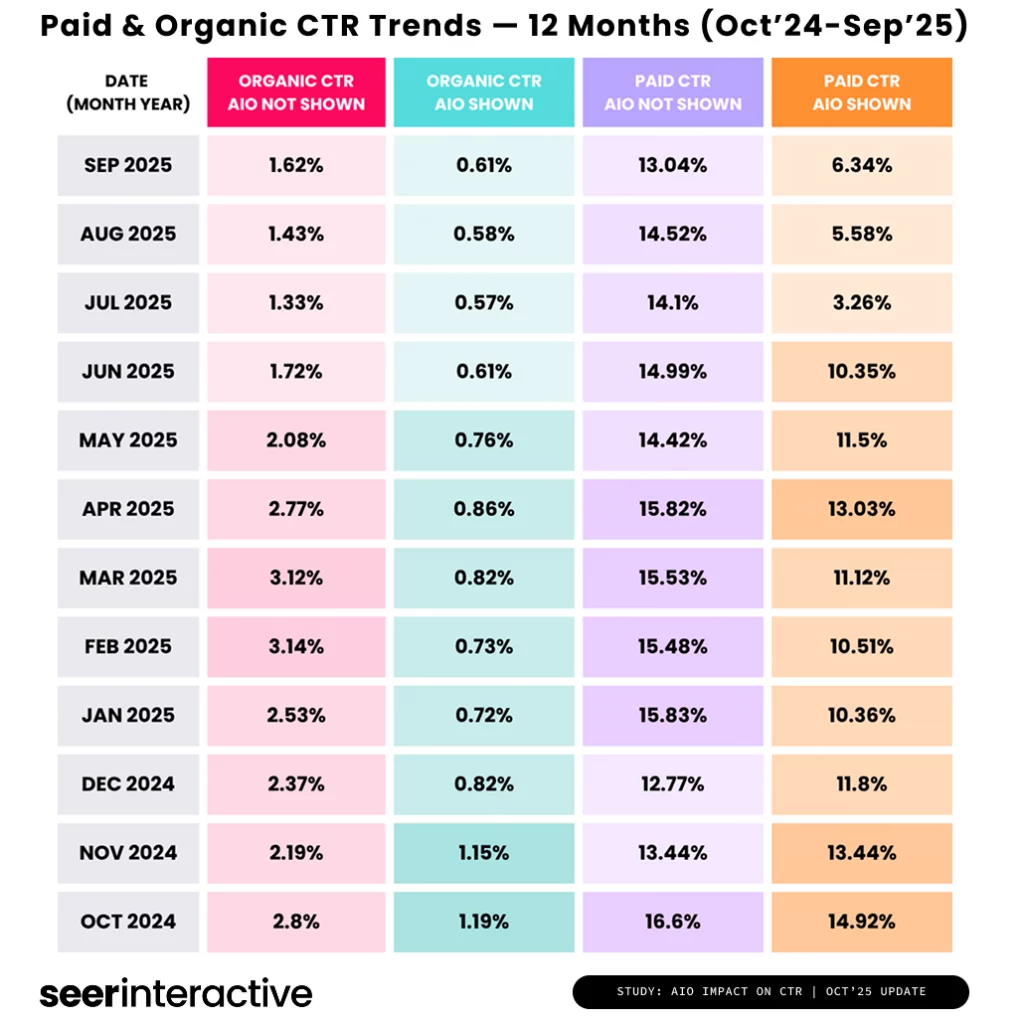

This aligns with Semrush’s April 2025 findings that AI engines are more likely to cite content containing verifiable statistics and credible references – a clear signal that factual depth now directly supports visibility in AI search.
Measure What Matters
Marketers want to measure everything. But with GEO, measurement itself has become a new challenge. New KPIs are emerging, including AI Citation Share, Overview Visibility, and Zero-Click Displacement Rate.
AI-sourced clicks are now tracked separately, as these visitors stay 2.3 minutes longer and convert 1.5× higher than users arriving through traditional organic search. (Source: Marketing LTB 2024)
Arrival of the Generative Layer
Then came the generative layer: ChatGPT, Claude, Gemini, Perplexity. These platforms aren’t search engines; they’re decision engines and don’t index: They infer.
Ask “What’s the best CRM for small creative agencies?” and you don’t get a list of ten blue links. You get a synthesised, conversational answer, one that feels closer to advice than information.
In the age of generative search, visibility begins with one question: Is your brand part of that answer?
Cornel Lazar
And that raises the question: is your brand part of that answer? If not, you’re missing from the very moment intent is shaped.
The Shift from Search Results to Synthesised Answers
What GEO Really Means
GEO = Generative Engine Optimisation
the process of helping your brand become visible and credible inside AI-generated responses.
- SEO helps you rank on a search page.
- GEO helps you appear within an AI’s answer.
It’s less about gaming algorithms and more about being accurately represented by systems that interpret, summarise, and recommend.
It shifts focus from visibility to interpretability. From optimising for clicks to ensuring your brand’s knowledge is clear, structured, and trustworthy enough to be included in generated outputs.
SEO vs GEO
| SEO | GEO |
|---|---|
|
|
|
|
|
|
|
|
Traditional SEO fought for rankings. GEO earns inclusion.
SEO was about keywords, backlinks, and metadata. GEO is about structure, credibility, and consistency. It doesn’t replace SEO; it builds on it.
The old rules still apply, but the new context demands a different mindset, one that values clarity over frequency and truth over noise.
In the new hierarchy of relevance between GEO and SEO: Clarity and trust now outperform volume and repetition.
Cornel Lazar
Here’s a practical Example
Imagine two brands selling sustainable activewear:
- Brand A produces keyword-heavy blogs on “eco-friendly gym clothes”.
- Brand B publishes clear, structured explainers on “sustainable performance fabrics”, citing real data and research.
When someone asks an AI assistant, “What are the most sustainable activewear brands?”, it’s Brand B that’s referenced.
The difference isn’t volume. It’s trust.
In this new model, clarity, structure, and credibility are the strongest ranking signals you have.
Traditional SEO vs GEO in Practice
1. From Traffic to Trust
Traditional SEO is measured in rankings, impressions, and sessions.
GEO is measured in AI citations, content trust, and brand representation.
The question shifts from “How do I rank higher?” to “How do AI systems perceive and describe my brand?”
In this new environment, reputation isn’t earned by gaming signals. It’s earned through data integrity and content quality.
2. From Keywords to Context
Generative engines interpret relationships, not just words.
That means:
- Structured data matters more than ever.
- Metadata consistency becomes a competitive advantage.
- Citations and authorship transparency signal credibility.
AI systems do not reward creativity for its own sake, they reward coherence. A well-written but unstructured article may never be seen. A clear, well-cited one will be remembered.
3. From Quantity to Depth
Where SEO rewarded scale, GEO rewards clarity and expertise.
In practice, this means publishing fewer but higher-quality pieces that establish authority in AI ecosystems. Thought leadership backed by verifiable data now outperforms shallow keyword articles.
In other words: write to teach, not to rank.
Building AI Visibility for Your Brand
AI systems can’t understand your brand, so they can’t recommend it. Visibility now depends on being interpretable, not just discoverable!
Here are key areas every GEO marketer should be considering.
1. Audit Your Content Architecture
Start cleaning up your structure.
Titles, headers, and metadata should be simple and specific.
Use schema markup to help machines recognise who you are, what you sell, and who your audience is.
→ I’ve been testing an approach with a structured, AI-facing information page that sits alongside a simple txt file. Together, they’re meant to organise key content for LLMs and generative search tools to interpret it more clearly.
If your content isn’t machine-readable, it isn’t discoverable.
2. Reinforce Trust and Transparency
AI systems prioritise signals of factual reliability.
- Cite credible, dated sources.
- Maintain visible author attribution.
- Regularly update factual data and statistics.
Transparency is now a ranking factor for the generative web.
3. Make Content Easy to Extract
Generative systems pull structured fragments to build context.
- Summarise key takeaways. Use concise definitions and explanatory statements.
- Integrate FAQs addressing real user questions.
- Structure lists, tables, and summaries clearly.
You’re not just writing for people anymore but writing for systems that explain things to people.
GEO v SEO: You’re no longer writing only for people. You’re writing for systems that explain things to people.
Cornel Lazar
4. Keep Your Brand Consistent Across Every Platform
Generative AI crawlers rely on cross-source validation. If your name, product details, or positioning differ across platforms, your credibility can drop.
Keep your digital footprint aligned. From your website to your LinkedIn metadata and partner listings.
5. Optimise for Natural Language
People are no longer typing search terms; they’re asking questions. Adapt your content to reflect that.
Instead of “sustainable running shoes London”, think “What are the best sustainable running shoes for city runners?”.
Listen to how your audience speaks. Then write like that.
6. Track the Right Signals
Analytics haven’t caught up yet, but we know of proxy indicators:
- Mentions in AI-generated summaries.
- Direct traffic trends despite fewer search clicks.
- Growth in AI-integrated browser referrals.
Measure what you can, and refine as the tools mature.
If you’re exploring GEO strategy for 2026 and want to discuss how the framework can work for your organisation, get in touch.
This Isn’t Hype: It’s the New Discipline of Discoverability
None of us have GEO fully figured out. Don't fall for AI Gurus and Magic GEO Tools. We’re all learning, testing, and shaping what AI discovery means in practice.
Cornel Lazar
SEO hasn’t gone, but its monopoly on visibility is being challenged and AI Visibility’s impact will only keep growing.
Marketers and brands are advised to adapt early, especially while most competitors are still at a similar point in the learning curve or struggling to keep up.
Whatever questions and uncertainties remain, one thing is clear: Experiment and keep building knowledge. We’re not chasing a hype.
Because the next time someone asks, “Who should I trust?”, the answer will depend on the brands that took the time to help shape that knowledge in the first place.
AI Visibility & GEO Glossary Extension
| Term | Definition | Why It Matters |
|---|---|---|
| Generative Engine Optimisation (GEO) | The practice of optimising content so AI systems such as ChatGPT, Perplexity, Claude or Gemini can accurately cite, summarise and represent a brand. | Ensures your brand is discovered inside AI-generated answers, not only in traditional search results. |
| AI Visibility | A broader discipline combining content optimisation, authority building and brand tracking across AI engines. | Moves beyond SEO to measure how your brand is represented and trusted in AI search and assistant answers. |
| AI Overview (AIO) | Google’s AI-generated summary box shown on some queries that often reduces organic clicks. | Affects both organic and paid performance; brands cited within AIOs retain visibility and traffic. |
| AI Citation Share | The percentage of relevant AI answers that mention or link to your brand, product or content. | Indicates how visible and trusted your brand is across AI engines and conversational responses. |
| Overview Visibility | A measure of how often your brand is cited or linked within Google AI Overviews for priority queries. | Helps quantify brand presence in Google’s generative results and track changes over time. |
| Zero-Click Displacement Rate | The estimated percentage of organic traffic lost when AI summaries answer queries without requiring a click. | Shows how AI responses divert traffic from your site and guides re-optimisation efforts. |
| AI Presence Mapping | A structured scan of how major AI engines describe your brand, key facts and sources. | Reveals inconsistencies and opportunities to correct or strengthen brand representation in AI tools. |
| Answer Influence | The degree to which AI systems use your preferred facts, claims and sources in generated answers. | Demonstrates thought-leadership and content authority — your brand shaping AI outputs rather than just appearing in them. |

